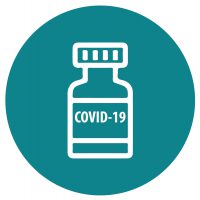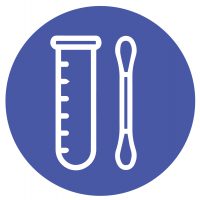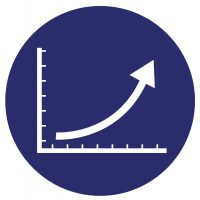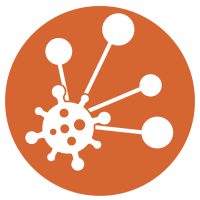Recommendations for Fully Vaccinated People
COVID-19 Homepage
CDC Public Health Science Agenda for COVID-19
Building the Evidence Base for Ongoing COVID-19 Response
Priority COVID-19 Public Health Science Questions
As the public health response to the COVID-19 pandemic continues to evolve, considerable progress has been made. We now have more tools than ever to prevent COVID-19 from placing strain on communities and healthcare systems. With current high levels of vaccination and high levels of population immunity from both vaccination and previous infections, the risk of medically significant disease, hospitalization, and death from COVID-19 is greatly reduced for most people (see more on COVID-19 hospital admission levels). It remains important to collect data-driven information on key priority areas that can help CDC and public health partners continue to fill critical scientific gaps, build on knowledge gained and advances made, and inform evidence-based decision-making for continued intervention through public health surveillance and epidemiologic research.
CDC has developed priority questions around 8 thematic topic areas for The CDC Public Health Science Agenda for COVID-19:
Within these topic areas, 15 priority public health science questions relate to the broad scope of CDC’s scientific work, both in the United States and globally, including public health surveillance, epidemiologic research, implementation science, and evaluation. These questions also relate to ongoing work in the broader scientific community (such as other government agencies, academics, the private sector). Other relevant questions are found in the complementary science agendas of other federal agencies, including the National Institutes of Health (NIH), the Food and Drug Administration (FDA), the Environmental Protection Agency (EPA), and the White House. This Science Agenda is intended to inform efforts by the broader public health research community. It is used to help direct and monitor CDC’s scientific activities but is not a commitment by CDC to address every question.
Importantly, these questions also serve to expand the evidence base to accelerate progress toward reducing COVID-19 health disparities and achieving health equity in prevention, testing, treatment, and management of post-COVID conditions. Health disparities are differences in health among groups of people that are linked to social, economic, geographic, and/or environmental disadvantage (social determinants of health), and health equity is achieved when everyone has a fair and just opportunity to attain their highest level of health. Our health equity priority question considers populations experiencing COVID-19-related health disparities including, but not limited to: age, sex, race, ethnicity, sexual orientation, socioeconomic status, disability, underlying medical conditions (especially compromised immune status), education, occupation, place and type of residence (single versus congregate housing and urban versus rural settings), and other social determinants of health that may not necessarily fall within other priority questions. However, health equity science remains a fundamental consideration for all priority questions, and there is some overlap in health equity science activities across questions.
Two priority questions were added in March 2022 to address research gaps in evaluating equitable access to treatments for COVID-19 and the effectiveness of COVID-19 treatments in improving outcomes from COVID-19, post-COVID conditions, and other conditions unrelated to COVID-19.
Key activities of public health importance that fall within the question domain are noted under each question.
Background for the CDC Public Health Science Agenda for COVID-19
The COVID-19 pandemic is a formidable global public health challenge. Since the initial emergence of a novel coronavirus in late 2019, the spread of SARS-CoV-2 has been unrelenting, impacting nearly every aspect of society worldwide. The pandemic has required a substantial response by public health authorities at all levels.
The Centers for Disease Control and Prevention (CDC) is at the forefront of the public health response to the COVID-19 pandemic and is a respected source of data and information used by public health, medical, and policy decision makers. From the beginning of the pandemic, CDC has been working with a wide array of partners to advance understanding of COVID-19.
The CDC Public Health Science Agenda for COVID-19 builds on CDC’s ongoing pandemic-related work. Importantly, the COVID-19 pandemic has underscored long-standing health disparities and inequities in the United States. Data-driven strategies are essential to address these disparities and improve the health outcomes of people disproportionately affected by COVID-19.1 The work set out in The CDC Public Health Science Agenda for COVID-19 is predicated on the use of culturally and linguistically appropriate approaches and methods and inclusion of populations at increased risk for health disparities and inequities to help reduce the impact of COVID-19 in these communities.
Goal of The CDC Public Health Science Agenda
The goal of The CDC Public Health Science Agenda for COVID-19 is to guide the development of the evidence base needed to strengthen the public health actions, guidance, and policy essential to limit the spread and impact of SARS-CoV-2 and ultimately end the COVID-19 pandemic.
CDC’s role and the scope of The CDC Public Health Science Agenda
CDC is providing leadership and technical expertise in the prevention and control of the COVID-19 pandemic by:
- employing public health fundamentals, including disease surveillance, laboratory detection, and epidemiologic investigation;
- identifying and implementing public health interventions to reduce disease transmission and the mitigation of its impact on health and well-being;
- developing evidence-based guidance and policies for disease prevention, detection, and control; and
- engaging in effective communication strategies to optimize uptake of protective behaviors and recommended actions.2
These key functions underpin The CDC Public Health Science Agenda for COVID-19.
Organization of The CDC Public Health Science Agenda
The CDC Public Health Science Agenda for COVID-19 was initially organized around a framework of six Priority Areas:
- Priority Area I. COVID-19 disease detection, burden, and impact
- Priority Area II. Transmission of SARS-CoV-2
- Priority Area III. Natural history of SARS-CoV-2 infection
- Priority Area IV. Protection in healthcare and non-healthcare work settings
- Priority Area V. Prevention, mitigation, and intervention strategies
- Priority Area VI. Social, behavioral, and communication science
For each of the six Priority Areas, a series of Objectives were described.
Priority Area I. COVID-19 Disease Detection, Burden, And Impact
Disease surveillance and laboratory detection are at the heart of CDC’s mission and fundamental to the COVID-19 public health response. They underpin CDC’s work with federal, state, tribal, local, and territorial (STLT), academic, and commercial partners to better understand the burden of COVID-19 disease and efforts to mitigate its diverse impacts, including the disproportionate impacts of COVID-19 on people at increased risk for health disparities and inequities. CDC supplements surveillance and laboratory methods with the modern tools of viral genomics and mathematical modeling.
- Objective 1. Develop new, or modify existing, methods of epidemiologic surveillance for COVID-19
- Objective 2. Develop and optimize testing for SARS-CoV-2
- Objective 3. Utilize viral genomics to advance understanding of COVID-19 and mitigate its impact
- Objective 4. Use mathematical modeling and other technological tools to forecast COVID-19 trends and measure the impact of interventions across a range of populations
- Objective 5. Assess and limit the impact of the COVID-19 response on healthcare services and public health programs in domestic and international settings
Priority Area II. Transmission of SARS-Cov-2
Understanding how SARS-CoV-2 is transmitted and the important factors that can facilitate its spread among people in healthcare, workplace, and community settings has been a high priority for CDC since the earliest days of the pandemic. This essential information is used to develop and update guidance about effective strategies to prevent, contain, and mitigate COVID-19.
- Objective 1. Refine understanding of SARS-CoV-2 transmission modes
- Objective 2. Identify host and virus factors associated with person-to-person transmission
- Objective 3. Assess and characterize transmission of SARS-CoV-2 across a spectrum of healthcare settings
- Objective 4. Evaluate transmission of SARS-CoV-2 in non-healthcare workplace and community settings/populations
- Objective 5. Evaluate transmission of SARS-CoV-2 between people and animals
Priority Area III. Natural History of SARS-Cov-2 Infection
The full spectrum of COVID-19 disease continues to unfold and confound in its clinical manifestations and requires careful study. CDC and its collaborators have been undertaking comprehensive clinical and laboratory investigations of confirmed cases across a range of age groups and populations to learn about the natural history of COVID-19 disease, associated medical complications, and the development of immunity.
- Objective 1. Define the spectrum and clinical course of SARS-CoV-2 infection
- Objective 2. Characterize the immune response in infected persons
Priority Area IV. Protection in Healthcare and Non-Healthcare Work Settings
Understanding and mitigating risks to patients, HCP, and non-healthcare workers across a range of settings is a high priority focus. CDC works to identify culturally and linguistically appropriate innovative strategies, tools, and practices which can supplement traditional infection control and worker safety measures to protect patients and reduce nosocomial and occupationally acquired SARS-CoV-2.
- Objective 1. Improve and assess the effectiveness of personal protective equipment
- Objective 2. Assess strategies to reduce transmission of SARS-CoV-2 in healthcare and non-healthcare work settings
Priority Area V. Prevention, Mitigation, and Intervention Strategies
CDC has disseminated a portfolio of prevention, mitigation, and intervention strategies tailored to specific settings and sectors to slow the spread of COVID-19 and protect individuals and communities. Evaluating the effectiveness of these strategies is critical to help refine public health guidance and recommendations. A key responsibility for CDC, in collaboration with STLT public health partners and academic and other researchers is monitoring the coverage, safety, and effectiveness of COVID-19 vaccines.
- Objective 1. Evaluate individual- and community-level strategies to limit infection with SARS-CoV-2
- Objective 2. Evaluate strategies to limit infection with SARS-CoV-2 in specialized settings or select populations
- Objective 3. Develop methods to detect SARS-CoV-2 in the environment
- Objective 4. Identify the most effective methods for contact tracing, testing, and monitoring
- Objective 5. Evaluate travel-related interventions
- Objective 6. Optimize the acceptability, coverage, safety, and effectiveness of COVID-19 vaccines
Priority Area VI. Social, Behavioral, And Communication Science
Effective communication requires community engagement; empowerment of individuals to take appropriate measures to reduce their risk; evaluation of risk communication methods and information gaps; and culturally and linguistically responsive materials and messengers. The effectiveness of risk reduction strategies, such as community mitigation or maximizing vaccine uptake, is dependent in part on understanding the barriers to implementation/acceptance, including economic and social determinants of health. Understanding the social, behavioral, and mental health impacts of the COVID-19 pandemic are as important as understanding the impacts to physical health.
- Objective 1. Understand where people receive information about the pandemic
- Objective 2. Optimize uptake of recommended behaviors and actions
- Objective 3. Enhance CDC communication products and information tools
- Objective 4. Assess the social and mental health impacts of the pandemic
Footnotes
- Populations of special focus include racial and ethnic minority populations; people living in rural or frontier areas; people experiencing homelessness; essential and frontline workers; people with disabilities; people with substance use disorders; people who are justice-involved (incarcerated persons); and non-U.S.-born persons.
- A CDC framework for preventing infectious diseases. See https://www.cdc.gov/ddid/docs/ID-Framework.pdf














